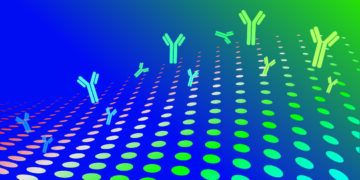
Rising from the Ashes: The History of the 488 nm Laser
Despite the pivotal role of the 488 nm (blue) laser in the rise in popularity of flow cytometry, it experienced somewhat of a fall from grace following the shift to higher usage of the 561 nm (yellow) laser. However, with the advancement of flow cytometry leading to the use of more complex multicolor panels and ever-increasing fluorophore numbers per experiment, the blue laser is starting to make a comeback. Discover how StarBright Blue Dyes can help you make the most out of your 488 nm laser.

StarBright Dyes for Flow Cytometry
Watch this video to learn about the many benefits of StarBright Dyes — our proprietary fluorescent nanoparticles — and see how they can help you build bigger, better flow cytometry panels with ease. StarBright Dyes have been designed to be stable, with superior brightness, narrow excitation and emission characteristics, and the flexibility to be included in new and existing experiments. They offer improved resolution of specific cell populations and minimized spillover and spreading.

Efficacy of a Novel Treatment for Multiple Myeloma Established by Flow Cytometry
Autologous stem cell transplantation (ASCT) is an effective treatment strategy for multiple myeloma (MM) but isolating enough hematopoietic stem and progenitor cells (HSPCs) for transplantation can be challenging. The selective CXCR4 inhibitor motixafortide has been shown to be a safe and efficacious HSPC mobilization agent in a phase 2 trial when paired with G-CSF. Crees et al. (2023) report the results of the phase 3 trial, in which they used the ZE5 Cell Analyzer to explore motixafortide’s mobilizing effects.

In-Cell Western: A Versatile Tool for Quantitative Analysis of Protein Expression In-Situ
Protein expression analysis is essential in cell biology research, as it provides valuable insights into the molecular mechanisms that underlie cellular functions. Traditional methods for protein analysis, such as western blotting and ELISA, are useful for studying protein expression in cell lysates. However, these methods require labor-intensive sample preparation and do not provide information on the spatial distribution of proteins within intact cells. In-Cell Western is a powerful technique that enables quantitative and qualitative in situ protein expression analysis.

Microphysiological Systems: A Game Changer for Drug Safety and Efficacy Studies?
In December 2022, a groundbreaking law was passed granting the U.S. FDA the authority to consider data from new alternative methods in the preclinical testing phase for new drug development. Among the new methods are 3D cell cultures that mimic human tissues and organs, known as microphysiological systems (MPS). The new law aims to improve clinical outcomes while decreasing reliance on animal testing. In this article, we discuss MPS and review data showing how they can synergize with Bio-Plex Assays.

How to Build Bigger Immunophenotyping Panels with StarBright Dyes
With the advancement of technology, flow cytometers are now able to detect a much greater range of fluorescent dyes, facilitating the analysis of more extensive and complex multicolor immunophenotyping assays. But this has also introduced more pitfalls to navigate during the design of these experiments. Find out how StarBright Dyes can help circumvent many of these issues, enabling consistent and reliable results.

Maximizing Metastasis Insights with a Novel Integrated Workflow for CTC Enrichment and Enumeration
Watch this webinar to learn how a novel workflow can efficiently isolate CTCs for diverse downstream applications, without disrupting their native biology.

Leading the Way in Our Understanding of COVID-19: Peptide Megapool Assays
Understanding how T cells respond to severe acute respiratory syndrome coronavirus 2 (SARS-CoV-2) is critical in developing long-term therapeutic approaches, as well as helping inform strategies for future pandemics. Learn how one team at the La Jolla Institute for Immunology in San Diego, California, has been using novel T-cell activation assays to understand how our immune system responds to SARS-CoV-2.

Advanced Cancer Therapeutics: Increasing Efficacy and Specificity and Reducing Toxicity
Research into human diseases has led to the development of novel monoclonal antibody drugs. These monoclonal antibody therapies have been successful because of their specificity and selectivity. However, ongoing development and successfully launching a new mAb drug require robust and reliable methods to screen for drug targets, demonstrate drug safety and efficacy, and scale up manufacturing to meet the stringent regulatory guidelines required for approval.

Immune Surveillance in SARS-CoV-2 Vaccine Development
The ability to characterize the target of cell-mediated immune response is crucial during vaccine development. In studying the characterization of SARS-CoV-2 infection pathogenesis in humans, a research team identified neutralizing antibodies that provided context for vaccine antigen design. Discover how the ZE5 Cell Analyzer was used to detect activation-induced markers, measure intracellular cytokines, and identify spike protein–specific antibodies in a rapid, high-throughput manner.
